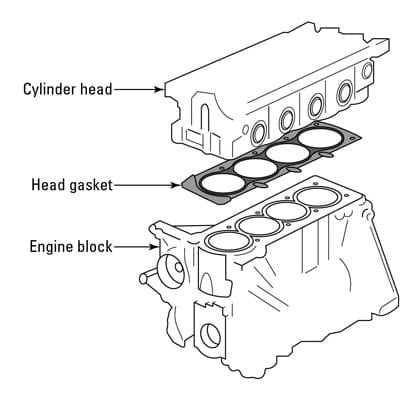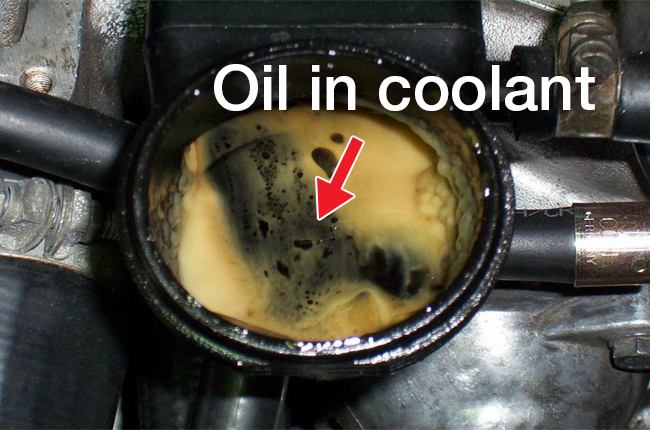Your car got overheated; now it just won’t start? There are two types of situations you might encounter:
- Car overheated, now it won’t start but still turns over
- Car overheated, it won’t start and no crank
Whichever situation you’re in, you’d better preparing to pay a decent amount of money to fix that.
Anyway, I’m here to help you verify what problem(s) you’re having and how much does it cost so that you can avoid being ripped off by mechanics.
Let’s get into it!
Table of Contents
Car overheated won’t start but turns over
If you’re turning the ignition key and your car make a “ruh ruh ruh” sound and no start, you may have an engine that is turning over, but there is no combustion to bring it to life.
In such cases, a few parts might be affected by the heat, and you need to diagnose which part is failing to remedy the situation.

Blown head gasket

Due to intense heat, the cylinder’s head and engine block could expand too much, resulting in a blown head gasket.
When the head gasket is gone, coolant will leak to the combustion room.
The coolant inside the combustion room can cause the engine to lose power and, eventually, no combustion. Therefore, your car can’t get started.
A blown head gasket will also cause unexplained coolant loss (can’t be found by a pressure test). This will again cause the engine to overheat more.
Blown head gasket symptoms
There are certain signs to help determine if the vehicle has had a failing head gasket.
- Excessive white smoke from vehicle’s exhaust
- Bubble formations in the radiator
- Coolant loss without any leaks
- Milky coolant due to infiltration of fuel and oil from leaks

If you’re experiencing any of the symptoms mentioned, you need to replace your blown head gasket with a new one.
Replacing a head gasket might sound simple, but it’s quite a daunting task. The steps involve reaching the engine, taking it apart, replacing the head gasket, and putting it back. Very time-consuming!
We recommend heading to a local mechanic to get your head gasket replaced. However, if you have DIY experience, you can look at this video to help you replace a head gasket at home.
Head gasket replacement cost
The cost of a new head gasket is not that much, but adding labor costs to it can make replacing your head gasket quite expensive.
This is because a mechanic might take a few hours to a couple of days to replace your vehicle’s head gasket.
Depending on your vehicle, a head gasket can cost anywhere between $100 to $350. In addition, the labor cost is around $1,500 to $2,000.
You would also need an additional $100 to flush and replenish the coolant in the vehicle as the process of replacing a head gasket involves draining the coolant from the car.
Bad piston rings/valves
An overheated engine can also affect the piston rings and valves (responsible for sealing engine cylinders).
To determine if your piston rings or valves have gone bad, you can do a compression test.
Just like the head gasket, replacing bad piston rings or valves is complicated as these parts are found inside the engine. It’s best to take the vehicle to a mechanic immediately before it starts to create more problems.
Piston rings/valves replacement cost
Piston rings and valves are inexpensive items that can cost you around $30 to $150, depending on the make and model of the vehicle.
Although the parts are inexpensive, the labor cost is quite hefty, as replacing these parts is time-consuming. Labor costs can set you back between $1,500 to $2,000.
Warped or cracked cylinder head
If you have a blown head gasket, there could be a chance that the cylinder head is warped. So it’s better to check the cylinder head for any damages.
Symptoms of a warped cylinder head remain the same as with all the others on this list.
The cylinder head should be completely straight and even. However, the intense heat can make the head expand too much, and when things cool down, it can’t get back to the original shape.

You can check this video to see how a professional checks a vehicle’s engine for a warped cylinder head using a straight edge tool.
A warped cylinder head can also have a crack in it. If it does, replacing the cylinder head is usually the least painful option.
Replacement/repair costs of a warped cylinder Head
If your cylinder head is warped slightly, you can remove the part from the engine and send it to a local mechanic for a quick flattening. This can cost you about $60 to $80.
However, if there is some serious damage (cracked or severely warped), you need to replace it. Replacing a cylinder head could cost you anywhere from $1000 to $2000 or even more
Car overheated won’t start and no crank
If your car won’t start, and no crank, you’ve got a much larger problem. With vehicles facing such issues, it is often because the engine is seized.
To check whether or not your engine is seized, you would need a 1/2″ breaker bar (or a ratchet). Use it to turn the crankshaft clockwise, if it doesn’t turn, you’re facing a seized engine which can be a huge problem.
Here how you can do it:
Engine replacement cost
Most of the time, a seized engine can not be repaired and requires rebuilding. The cost of having a mechanic to rebuild the entire engine can be around $3,000 to $5,000, sometimes much more than that.
Or you can consider buying a used engine.
If the replacement cost is too high, it might be better to sell your vehicle.
In such cases, approach junk car companies for a quotation. If selling the car makes more sense, go for it and save some cash to buy a used or a new car.
Fix the root – Overheated engine
We’ve discussed how an overheated engine can affect a vehicle’s parts and how to diagnose these. Now let’s go to the root problem, which is an overheated engine.
Common causes of an overheated engine
Little or no coolant
Coolant should be refilled according to the manufacturer’s recommendation as low coolant levels may cause a coolant system failure.
Coolant reservoir leaks
Your vehicle may be overheating because there might be a leak in the coolant reservoir, causing depletion of the coolant in the vehicle.
Broken water pump
A water pump ensures that the coolant flows consistently into the engine to keep the engine cool, but a broken water pump can affect the flow of the coolant leading to an overheated engine.
Radiator issues
As the coolant circulates inside the engine, it increases in temperature. Radiators and their fans regulate the coolant temperature, ensuring it stays cool. However, a broken radiator or fans can affect this process.
Oil too low
Motor oil is also responsible for regulating temperatures, and having low levels of oil can impact temperatures leading to an overheated car.
Thermostat failure
A broken thermostat will affect the flow of the coolant as it might not allow it to pass through the engine, causing the engine to overheat.
Issues with belt and hoses
Belt and hoses are used to maintain air and coolant inside the engine. Ruptured belts and hoses will cause coolant leaks.
Blocked heater core
A blocked heater core can affect the flow of the coolant, leaving your car to overheat.
How much does fixing an overheated engine cost?
| Cause | Cost (including labor) |
|---|---|
| Little or no coolant | $100 - $200 |
| Coolant reservoir leaks | $100 - $240 |
| Broken water pump | $310 - $730 |
| Radiator issues | $300 - $1,200 |
| Oil too low | $70 - $200 |
| Thermostat failure | $200 - $300 |
| Belt and hoses | $120 - $160 |
| Blocked heater core | $550 - $990 |
What to do when your car overheats?
Usually, drivers don’t know what to do with an overheated car and continue to drive, which further damages the vehicle leading to high repair costs. If your vehicle is overheating, remember to follow these steps:
- Turn your AC to heater settings to draw out heat from the engine.
- Pull over to a safe location.
- Check and replenish coolant.
- Restart the engine and head to a local repair shop.
If the coolant level is okay, then you have a bigger problem. Call a tow company to have your vehicle towed to the nearest mechanic to avoid further damage to your car.
Things to avoid when your car overheats
Here are a few things you should avoid doing when your car overheats.
- Panicking
- Driving
- Opening the hood immediately
- Not taking it to a mechanic
Conclusion
An overheated car is a problem many drivers face. Unfortunately, it’s not an issue until the problem is prolonged, which can complicate things.
For that reason, you need to take care of the problem causing overheating issues immediately to avoid hefty replacement costs in the future.



